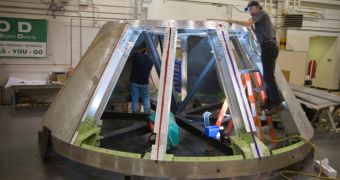There haven't been too many pieces of good news related to the Constellation project, and especially to the Ares I rocket as of late. At some point, even its ability to fly or to be completed on schedule was questioned and some NASA internal turmoil linked to the subject ended up with some resignations and skeptical anonymous statements. But it appears things are going better, as NASA technicians are testing engines and building the various parts of the rocket that will soon be tested.
Currently, tests and assessments are being performed with the help of computers, but unmanned demonstrative take-offs will follow, starting next year. Ares I-X, for instance, the first testing version of the Ares I rocket, is set for launch from the Kennedy Space Center in Florida next summer, when it rises up to an altitude of about 40 km (25 mi). The engines will be powered for about two minutes, providing insight on the first stage performance and separation of the Ares I, as well as on the parachute recovery system and general vehicle aerodynamics.
For better results, simulating versions of the other parts are also being built against the clock, such as the full-scale simulations of the upper stage, the Orion crew module and the launch abort tower. The simulated crew module will have a diameter of approximately five meters (16.4 ft), and will have a 14-meter (46-foot) long launch abort system placed above during the flight. Some 150 sensors located at the front tip of the rocket will record aerodynamic pressure and temperature, monitor vehicle acceleration and its angle of attack.
"We are a highly matrixed team – a lot of people from various organizations – that must work together successfully on a tight schedule," stated Kevin Brown, project manager for the Ares I-X Crew Module/Launch Abort System (CM/LAS) project, cited by NASA's official site. "We have a team doing fabrication and assembly work in conjunction with an off-site contractor, and we have another team readying to install about 150 sensors once the crew module and launch abort tower are completed."
"This launch will tell us what we got right and what we got wrong in the design and analysis phase," explained Jonathan Cruz, deputy project manager for Ares I-X CM/LAS. "We have a lot of confidence, but we need those two minutes of flight data before NASA can continue to the next phase of rocket development." The finished parts are expected to be delivered to the Kennedy Space Center this month.

 14 DAY TRIAL //
14 DAY TRIAL //